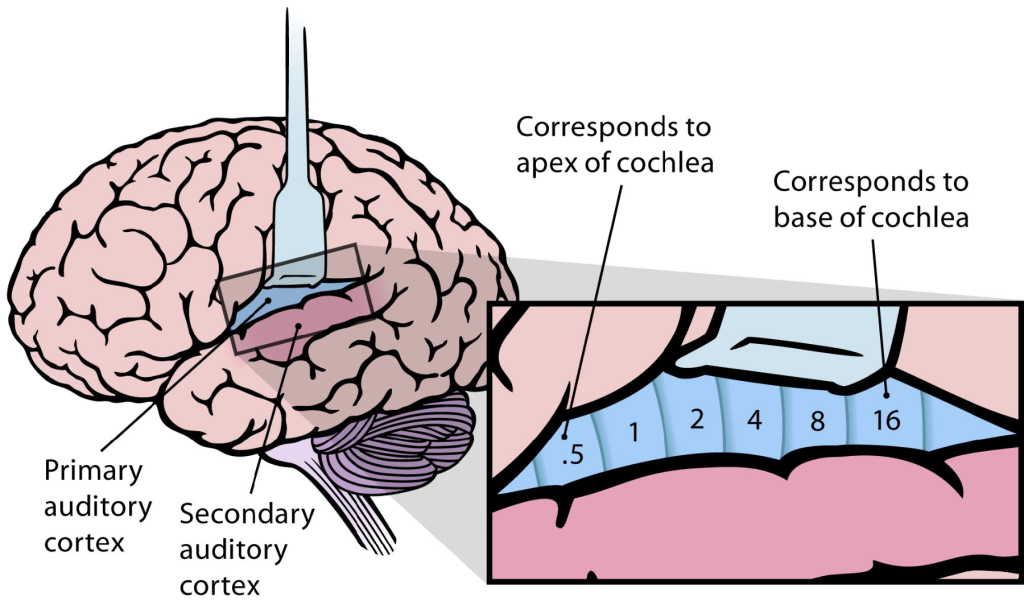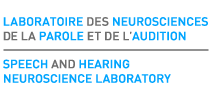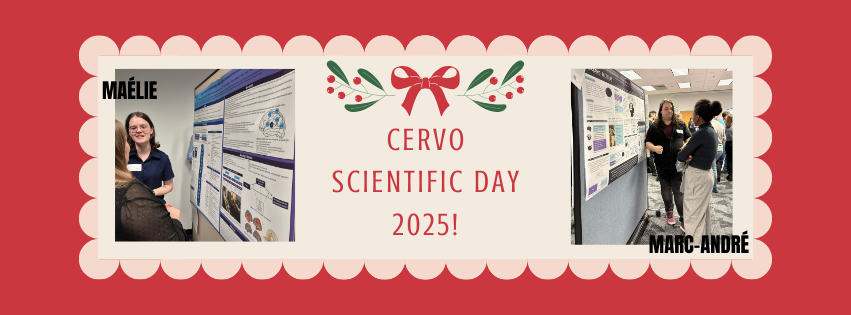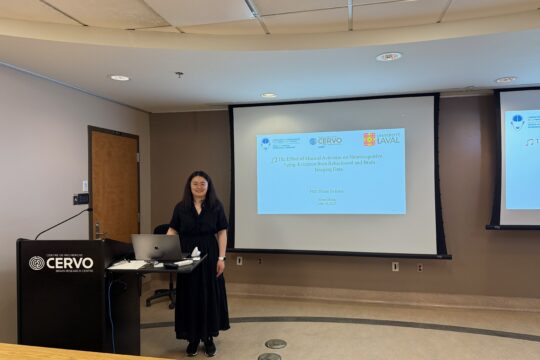This text is the third in the series on speech processing. In previous publications, we presented the peripheral auditory system, which is the entry point for all sounds, as well as the central subcortical auditory system, which carries sounds from the ear to the brain. In this post, we will discuss the functioning of the central “cortical” auditory system, that is to say, the auditory cortex.
From the thalamus, the auditory signal travels to the primary auditory cortex, located in Heschl’s gyrus in the temporal lobe, approximately at the height of the top of the ears (Litovsky et al. 2021). It is called “primary” because it is the first brain region that receives and analyze the auditory signal. As in the cochlea, pitch information (low to high) is organized, and processed, in a specific order within the primary auditory cortex: low-pitched sounds are processed in the anterior part (towards the forehead) and low-pitched sounds are processed in the posterior part of the auditory cortex (see figure 1). This spatial organization is called “tonotopy”.

Figure 1. Spatial coding of sound frequency in the primary auditory cortex (Auditory Cortex Frequency Mapping) by Chittka, L. and Brockmann, A. licensed under CC BY 2.5. Lower-pitched sounds (e.g., at a frequency of 0.5 kHz), which vibrate the apex of the cochlea, are processed in the anterior part of the primary auditory cortex, while higher-pitched sounds (e.g., at a frequency of 16 kHz), which vibrate the base of the cochlea, are processed in the posterior part of the primary auditory cortex.
The analysis of sound characteristics (frequency, duration, location, intensity), initiated in the brainstem, continues in the auditory cortex. In this region, the auditory scene is constructed. An auditory scene is similar to a visual scene but in the auditory modality. Our eyes pick up dazzling amounts of light of different colours and degrees of intensity from different places. Our visual cortex must build, from these light sources, a mental representation of the landscape we are looking at (which will allow us to identify the outlines of objects, their approximate distance, their colour, etc.). Similarly, the auditory cortex must integrate all perceived sound information and form a coherent “whole”: the auditory scene.
Studies have suggested that the hemispheres of the brain have different “specialties” (Zatorre et al., 2022) for analyzing sounds: the right auditory cortex would be specialized in processing pitch (i.e., from low or high pitch), which is important in identifying a speaker or a melody. The left auditory cortex would be specialized in processing sound duration (which is particularly important in speech analysis). Because of different specialties, damage to the left or right auditory cortex affect auditory perception differently.
A dysfunction in the auditory cortex can lead to one of the different types of “central auditory processing disorder”. People who live with such a condition have difficulty processing the characteristics of sounds, although they are not deaf (i.e., their ear and peripheral auditory system are intact). Central auditory processing disorders have a negative impact on communication. For example, it may be difficult for individuals with central auditory processing disorder to follow conversations when there are multiple speakers, due to difficulty in determining the localization of sounds. Remember that the auditory cortex is involved in the construction of the auditory scene.
Tinnitus is another example of a perceptual phenomenon that may be related to abnormal activity in the central auditory system. Tinnitus is manifested by the perception of a noise (hissing, sizzles) in the absence of external noise (Kaylie, 2021). It should be noted, however, that the causes of tinnitus are multiple and include ear infections, hearing loss, and ototoxic medications (medications that can damage the hearing system permanently) (Kaylie, 2021). Although tinnitus is rare and temporary for most individuals, 5–10% of the population lives with chronic tinnitus (Hear-it, 2021) which can affect sleep quality, communication skills and even mental health.
When central auditory processing is successfully completed, additional (linguistic and semantic) analyses are required for the processing of speech sounds, in order to identify and interpret the speech sounds, and, ultimately, to understand the meaning of the message. The speech signal therefore continues its journey inside the brain! These next steps will be discussed in the next article in this series.
Other texts in the series:
— The peripheral auditory system (text 1 of 4).
— The central subcortical auditory system (text 2 of 4).
— Speech perception: a complex ability (text 4 of 4).
References:
Hear-it. Prévalence des acouphènes. Récupéré le 20 janvier 2022 du site web: https://www.hear-it.org/fr/prevalence-de-lacouphene
Kaylie, D.M. Le manuel Merck, version pour professionnels de la santé. Merck and Co., Inc. Récupéré le 22 janvier 2022 du site web: https://www.merckmanuals.com/fr-ca/professional/affections-de-l-oreille,-du-nez-et-de-la-gorge/prise-en-charge-du-patient-présentant-une-affection-de-l-oreille/acouphènes
Litovsky, R.Y., Goupell, M.J., Fay, R.R., & Popper, A.N. (2021). Binaural hearing (Ser. Springer handbook of auditory research, v. 73). Springer. https://doi.org/10.1007/978-3-030-57100-9
Zatorre, R.J., Belin, P., & Penhune, V.B. (2002). Structure and function of auditory cortex: music and speech. Trends Cogn Sci, 6(1): 37-46. doi: 10.1016/s1364-6613(00)01816-7


